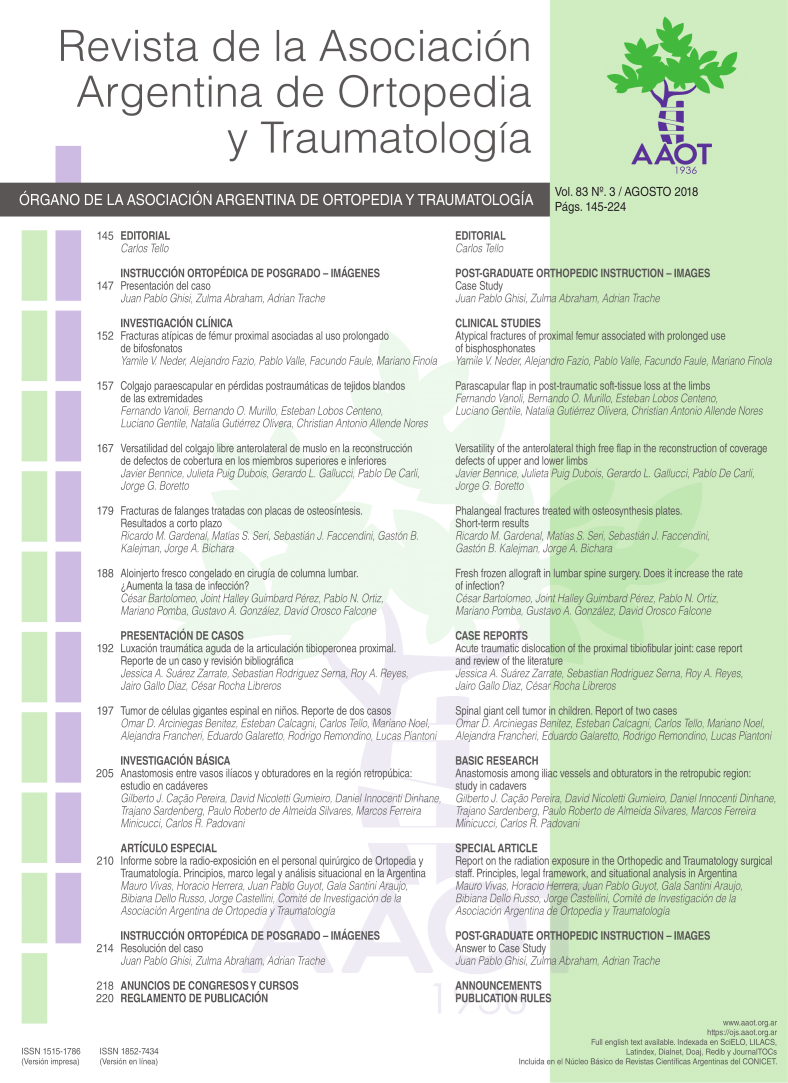Anastomosis among iliac vessels and obturators in the retropubic region: Study in cadavers.
Main Article Content
Abstract
Downloads
Metrics
Article Details

This work is licensed under a Creative Commons Attribution-NonCommercial-ShareAlike 4.0 International License.
Manuscript acceptance by the Journal implies the simultaneous non-submission to any other journal or publishing house. The RAAOT is under the Licencia Creative Commnos Atribución-NoComercial-Compartir Obras Derivadas Igual 4.0 Internacional (CC-BY-NC.SA 4.0) (http://creativecommons.org/licences/by-nc-sa/4.0/deed.es). Articles can be shared, copied, distributed, modified, altered, transformed into a derivative work, executed and publicly communicated, provided a) the authors and the original publication (Journal, Publisher and URL) are mentioned, b) they are not used for commercial purposes, c) the same terms of the license are maintained.
In the event that the manuscript is approved for its next publication, the authors retain the copyright and will assign to the journal the rights of publication, edition, reproduction, distribution, exhibition and communication at a national and international level in the different databases. data, repositories and portals.
It is hereby stated that the mentioned manuscript has not been published and that it is not being printed in any other national or foreign journal.
The authors hereby accept the necessary modifications, suggested by the reviewers, in order to adapt the manuscript to the style and publication rules of this Journal.
References
2. Tornetta P, Hochwald N, Levine R. Corona mortis, incidence and location. Clin Orthop Relat Res 1996;(329):97-101.
3. Henning P, Brenner B, Brunner K, Zimmermann H. Hemodynamic instability following an avulsion of the corona mortis artery secondary to benign pubic ramus fracture. J Trauma 2007;62(6):E14-7.
4. Sagi HC, Afsari A, Dziadosz D. The anterior intra-pelvic (modified Rives-Stoppa) approach for fixation of acetabular fractures.
J Orthop Trauma 2010;24(5):263-9.
5. Archdeacon MT, Kazemi N, Guy P, Sagi HC. The modified Stoppa approach for acetabular fracture. J Am Acad Orthop Surg 2011;(19):170-5.
6. Kellam JP, Tile M. Surgical techniques. En: Tile M. Fractures of the pelvis and acetabulum, Baltimore: Williams &Wilkins; 1995:365.
7. Goodman LA. Simultaneous confidence intervals for contrasts among multinominal population. Ann Math Stat 1964;35(2): 716-25.
8. Zar JH. Biostatistical analysis, 4ª ed. New Jersey: Prentice Hall; 2009:994.
9. Talalwah WA. A new concept and classification of corona mortis and its clinical significance. Chin J Traumatol 2016;(19):251-4.
10. Teague DC, Graney DO, Routt ML Jr. Retropubic vascular hazards of the ilioinguinal exposure: a cadaveric and clinical study. J Orthop Trauma 1996;10(3):156-9.
11. Sarikcioglu L, Sindel M, Akyildig F, Gur S. Anastomotic vessel in the retropubic region: corona mortis. Folia Morphol (Warsz) 2003;62(3):179-82.
12. Letournel E, Judet R. Surgical approaches to the acetabulum. En: Letournel E, Judet R. Fractures of the acetabulum, 2nd ed. Berlin: Springer-Verlag; 1993:379-81.
13. Cole J, Bolhofner B. Acetabular fracture fixation via a modified Stoppa limited intrapelvic approach. Clin Orthop 1994;305: 112-23.
14. Berberoglu M, Uz A, Ozmen MM, Bozkurt MC, Erkuran C, Taner S, et al. Corona mortis: an anatomic study in seven cadavers and endoscopic study in 28 patients. Surg Endosc 2001;15(1): 72-5.
15. Drewes PG, Marinis SL, Schaffer JL, Boreham MK, Corton MM. Vascular anatomy over superior pubic rami in female cadavers. Am Obstet Gynecol 2005;193(6):2165-8.
16. Karakut L, Karaca I, Yilmaz E, Burma O, Serin E. Corona mortis: incidence and location. Arch Orthop Trauma Surg 2002; 122(3):163-4.
17. Rubel IF, Seligson D, Mudd L, Willinghurst C. Endoscopy for anterior pelvis fixation. J Orthop Trauma 2002;16(7):507-14.
18. Requarth AJ, Muller RP. Aberrant obturator artery is a common arterial variant that may be a source of unidentified hemorrhagic in pelvic fracture patients. J Trauma 2011;70(2):366-72.

